

Originally posted February 21, 2017
This week in Gun of the Week: a gun I couldn't have made myself, but I know at least one person who could've.
Here is a shotgun.

This is a Stevens 9478 I got from my grandfather, and it is by far the simplest cartridge-based firearm I own. Only my single-shot black powder percussion pistol is simpler than this, and then pretty much only because, being a muzzleloader, it doesn't open up or have an extractor.
There's not a lot of history to tell here. We've seen the Stevens name before, and talked a bit about the history of the company.
Information on individual Stevens products after the takeover is pretty thin on the ground, but the Model 94 shotgun appears to have debuted in the 1960s, long after Stevens had become the Squier to Savage's Fender, and was the kind of gun you used to be able to buy with Sears, Roebuck & Company's own branding on it out of their catalog. Hordes and hordes of them were made, with various incremental changes over the years; I've seen references to versions with a letter appended (Model 94B, Model 94D, that kind of thing), and then later ones with another number tacked onto the first. The 9478 version, as we see here, debuted in the late 1970s and seems to have been produced through about 1985.
I'm not entirely sure why my grandfather would've bought one, to tell you the truth. He didn't hunt birds—by the 1980s he no longer hunted much of anything, having gotten bored with it—and he had plenty of other more suitable guns for defending the homestead if he needed to do so. He even had another shotgun, a nifty little over-under rig where the top barrel was a .22 rimfire rifle and the bottom one was a 20-gauge shotgun, which had belonged to my father as a teenager and been left behind when Dad moved out. My guess would be he just kind of wanted one, and one of the abiding virtues of the Savage-Stevens product line, then as now, was that they were cheap.
Which is not to say they're necessarily of poor quality. This is an absurdly simple shotgun, but it doesn't give the impression of being flimsy or shoddily made. It's just... incredibly basic. Almost defiantly so by modern standards. There's no polymer stock, no profusion of accessory rails, no quick-change (or slow-change, for that matter) choke (a widget in the bore that changes the pattern of shot); it barely even has sights. This shotgun is never going to be "tacti-cool".
So what's going on here? Well, this is a single-barrel, single-shot, break-open 12-gauge shotgun. Very similar weapons have been around since probably ten or fifteen minutes after the invention of the metallic cartridge. They compete with side-by-sides to be the third part of the holy trinity of cowboy firearms (along with the lever-action rifle and single-action revolver). The markings on the barrel of this one proudly specify that it will accept both 2¾" and more powerful 3" shells, and... that is the full extent of its Advanced Capabilities.
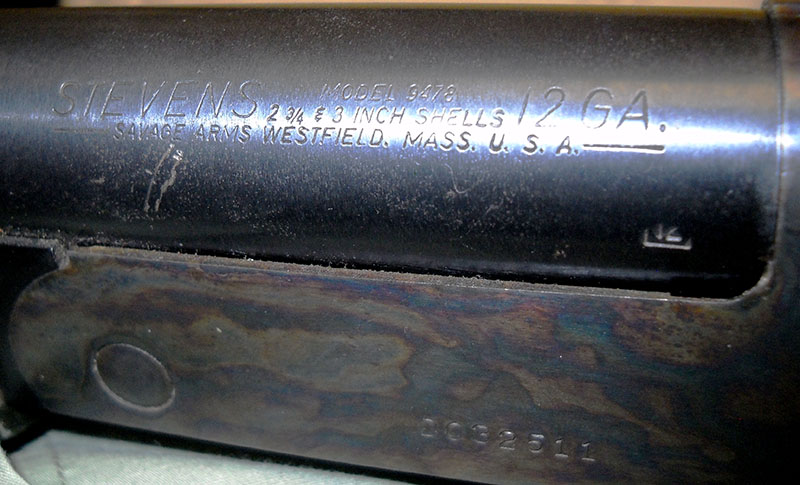
(That's also the extent of its markings. I'm not sure what the partly-worn-off boxed-12 in the lower right is; could be another indication of gauge, or a proof mark. Guessing the latter. That's some nice color case-hardening on the receiver, though, isn't it?)
Shall we open it up? That's basically the only thing it does, so we'd better, or this is going to be an even shorter post than it's already going to be.
First things first: the 9478 has a single-action trigger mechanism with an exposed hammer. To open and close it safely, the hammer should be in the half-cock position.
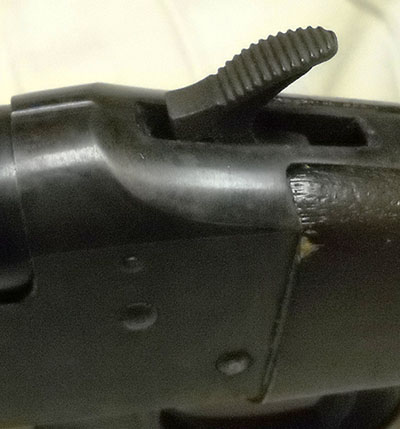
This is as opposed to the down/"fired" position or the fully cocked/"ready to fire" position.
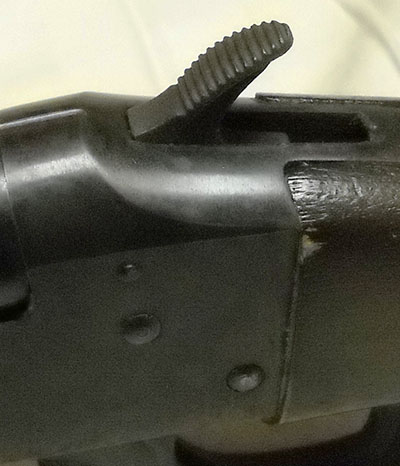
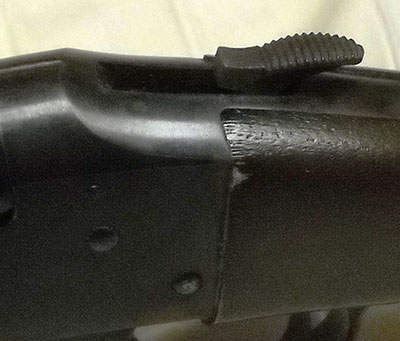
This is important, because with the hammer fully down the firing pin can protrude into the chamber. This could end poorly if you were to put a shell in there and shut the action smartly. Also: the half-cock is this shotgun's only safety. Interestingly, it won't let you open the action with the hammer cocked, but doesn't seem to have a problem letting you do so with it all the way down. That seems like a bit of an oversight, but it's conceivable that this one isn't quite working properly.
Anyway, once it's in half-cock, the release is this sorta-second-trigger-like button on the front of the trigger guard.
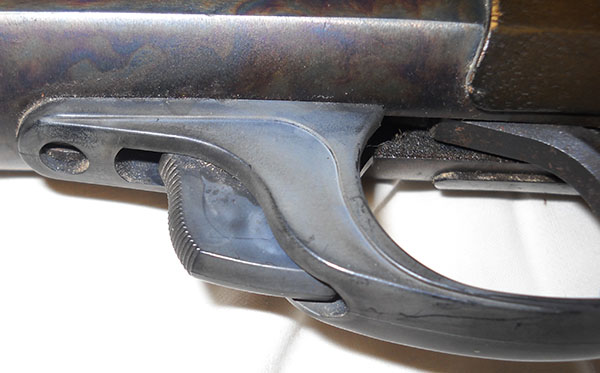
Once that's pressed, the action unlocks and the gun breaks open.
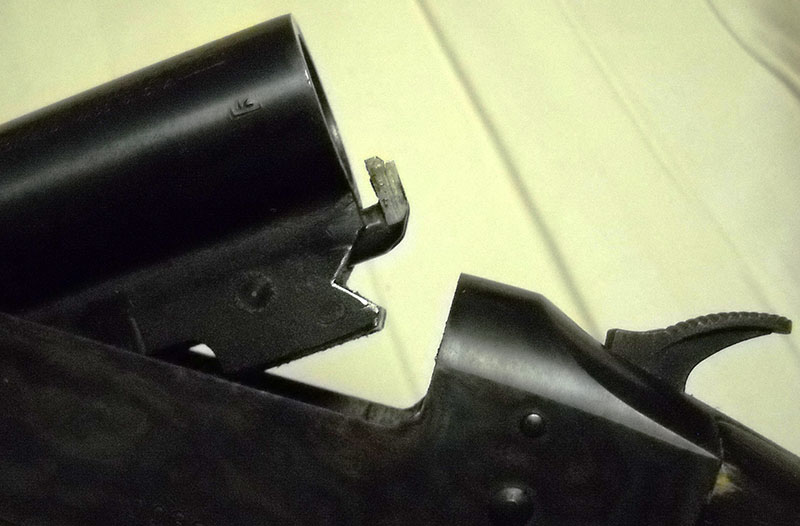
In old paintings of, e.g., duck hunting scenes, you will often see the hunters depicted with their empty guns (single-barrel, side-by-side, or over-under) open like this and draped over one arm. This was a safety technique, sadly invalidated by the development of the repeating shotgun. You can't accidentally shoot yourself or your hunting buddies with an empty shotgun that's open and hanging over your arm. (Similarly, competitive shotgunners may only close their guns when they are immediately ready to call for a target, similarly to minimize the potential for an accidental discharge.)
Notice the bit sticking out from the barrel. That's the extractor; when the shotgun hinges open, that comes out in the manner shown and pushes the rim of the shell out, so that you can pull it easily out of the chamber and discard it. (Or turn the shotgun over and shake it out; that usually works, unless the hull is particularly sticky.) The extractor is cammed so that it automatically retracts when the shotgun is closed again.
When I said this gun barely even has any sights, I meant it. The front sight doesn't look too bad:
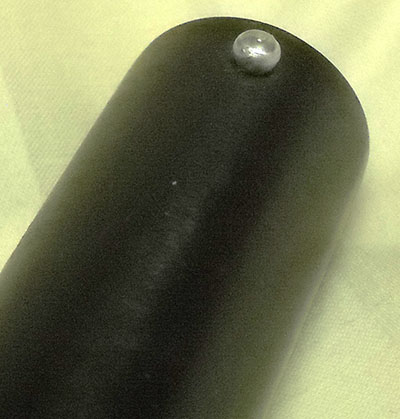
There's not a lot to it, but it's at least a visually distinct little bead. You may have noticed the rear sight in some of the other photos, though. If not, here's a closer look.
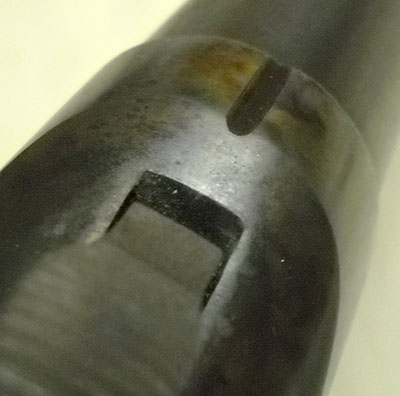
Yep. That looks like it's going to accomplish a lot, doesn't it?
Now, admittedly, this is a shotgun, they're not renowned for their... you know, precision. Still, they do have to be aimed at least a bit, and it seems to be that a bit of aiming is all you're going to do with this setup.
And that's... basically it! So there you go. Almost certainly the simplest firearm we'll see here until and unless I decide to do one on a muzzleloading musket. Single-bore shotguns used to be one of the gateway drugs of the shooting sports, because of their simplicity of operation—put in shell, close action, cock hammer, goes bang—and may well still be in some circles. I wasn't raised around bird hunters, though, so my own firearms education started with a bolt-action rifle and went from there. We didn't get to shotguns until later.
Oh yeah. Speaking of shotguns, kind of, want to see something silly?
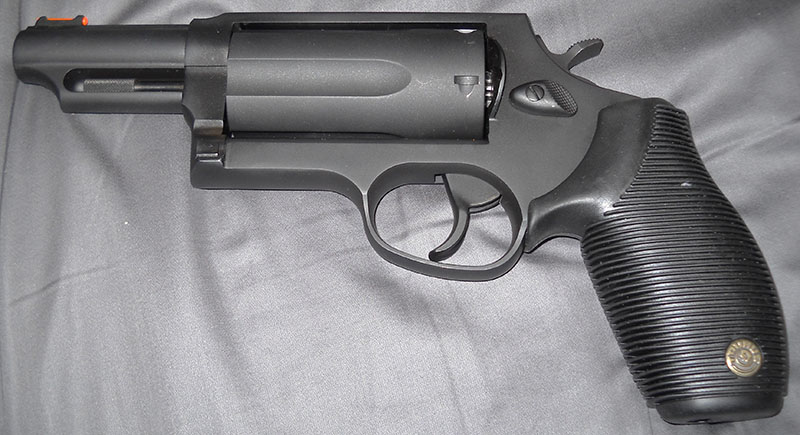
"What the hell is wrong with that revolver?" I hear you cry. Well, funny story. Nothing's wrong with it, as such. It's just that it's designed to take absurdly long cartridges.
These cartridges.
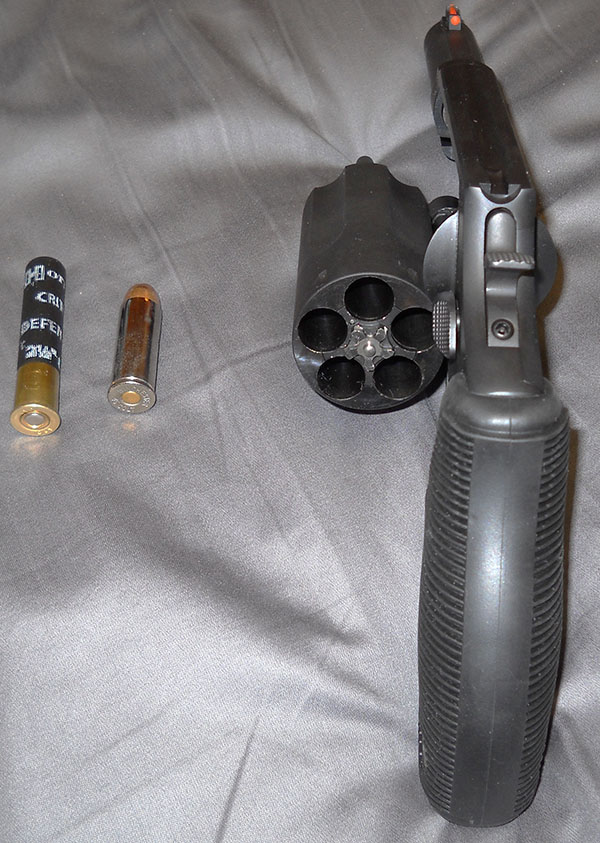
Yep. It's a revolver designed to take .45 Colt (also known as .45 Long Colt, because there used to be a .45 S&W that was shorter) cartridges or .410 shotshells. Because who doesn't want a revolver with a cylinder that's longer than some entire handguns?
Even sillier, in some respects, than this gun's chambering is its name, which the manufacturers were so pleased with that they put it on the side of the barrel in large, friendly letters.
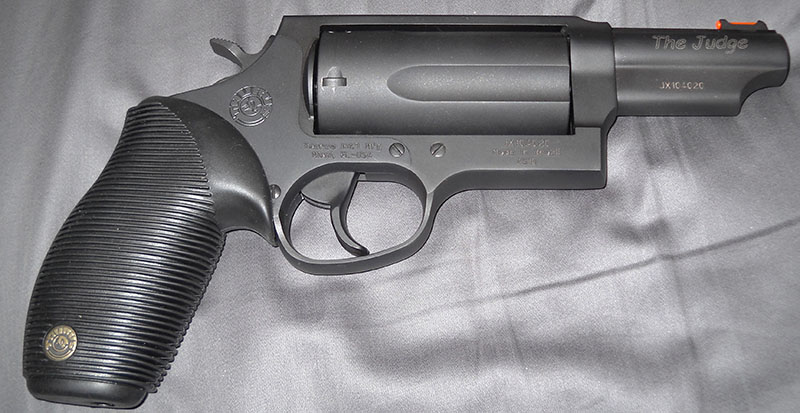
Yup. Say hello, then, to the Taurus Judge, or, I guess, technically the Taurus The Judge: a five-shot revolver with a barrel significantly shorter than its own cylinder, or an exercise in designing a handgun that looks like the result of one of those "iPhone panoramic camera" failures where you get a 20-foot-long, 18-legged catipede.
Taurus is a Brazilian company that started out with technical assistance (for which read some old machine tools and instructions on how to set them up) from Smith & Wesson and Beretta, which is why, for the first 20 or so years of the company's life, it produced exclusively revolvers that looked uncannily like Smith & Wessons and automatic pistols that looked uncannily like Beretta Model 92s. Nowadays they've branched out a bit, although the Smith design lineage is still pretty apparent in their revolver line. The Judge here started out as a mortal .45 Colt large-frame revolver, until it occurred to someone that a .45-caliber chamber would accommodate .410 shotshells if only the cylinder were long enough to hold them.
This strikes me as a pretty wacky idea, though if you believe the company's marketing department, it's caught on in some circles. They market it as being an ideal tool for home defense or use against carjackers (I think I would hesitate to fire one of these things in a space as confined as a car, personally, but don't go by me). It's a bit large to really qualify as a concealed carry piece, although allegedly, they call it The Judge because when it was first introduced (under the rather more prosaic name "Model 4410"), judges in places where it's dangerous to be a judge started buying them to pack in the courtroom. I guess concealability is a relative thing when you wear a graduation robe at work. Presumably they'd also be popular with wizards for similar reasons.
I'm... not sure I believe the "judge" thing, frankly, but it's a good story, and you could do worse for a profession to name a firearm after. No one would be particularly impressed by a pistol called The Accountant or The Insurance Adjuster. (Actually, The Insurance Adjuster would be a pretty good tongue-in-cheek name for e.g. a Mare's Leg style lever-action "rifle pistol". I mean, if I had one, that's probably what I would call it. But I digress.)
Even with that ribbed rubber (or, as Taurus's website cheerfully calls it, "ribber"—oh, you scamps!) grip, I'm guessing The Judge is a pretty unpleasant handgun to shoot. It seems to be made of a fairly lightweight alloy, and .410 might be a puny shotgun cartridge, but it's pretty frickin' big to put in a handgun. Still, there seems to be plenty of demand, enough that (in an amusing reversal) Smith & Wesson now sells an eerily similar product called "The Governor" (really, guys?).
(As an aside, I have to wonder how many people are buying these things just for the novelty value, and because (unlike, for instance, those insane .500-caliber S&Ws or .50-AE Desert Eagles) they're very reasonably priced for the sheer amount of gun you're getting. Hell, that's what I did. Spotted it in a display case while looking to see if the shop had something I was actually looking for (they didn't), said, "What the hell is that? It looks preposterous, I must have it," and left with a small artillery piece.)
Whatever the reason for it, there's enough demand that some ammunition manufacturers are now making .410 shells specifically configured to be used in this kind of combi handgun. Hornady, for instance, makes something called a "Critical Defense" round (shown above), which contains a .41-caliber bullet with a pair of 000 buckshot behind it, for optimized fusilladery. I'm not sure how, or if, they get a .41-caliber bullet to interact with the pistol's .45-caliber rifling; maybe it has a Minié-style skirt, or maybe they just don't.
It is rifled, though; it has to be, or the ATF would classify it as an Any Other Weapon under the National Firearms Act and there would be a shit-ton of paperwork. (In California, they're flatly illegal, under that state's controversial I Don't F--king Think So, Jack statute.¹)
So, yeah. If you thought you'd never see a sillier firearm in these pages than the HK 416 pistol, well, so did I! But our Brazilian friends had other ideas.
"The Judge". Seriously. The last product I know of called The Judge was a special version of the Pontiac GTO that was offered in 1969, one of the musclecar era's last "like our factory hot rod, only even hot roddier!" packages. My dad bought one when I was in high school. It turned out to be a forgery (it was an ordinary GTO that someone had put a Judge deco kit on).

That would be harder to do with this one, but I would believe that the name comes from a similar "more is more" philosophy sooner than that story about judges in Miami packing them. Although, then again, Miami.
--G.
Addendum originally posted March 3, 2017
OK, so, funny story. I was on my way home from campus today (dropping off the midterm exam, spring break starts tomorrow, woohoo), and decided on a whim to stop off and browse my local sports shop. Their stuff is usually pretty pedestrian by my standards, but occasionally something interesting floats through. Didn't really see anything that tripped my radar in the handgun case or the regular rifle/shotgun racks (except for a really nice old Auto-5 shotgun that was just a little too rich for me after Other Recent Expenditures), but I was standing there by the counter chatting with Jim (who is either the Assistant Proprietor or a partner, I'm not sure how the business is set up), and while he was lamenting that he cannot at present get me a CZ 75B for love or money for some reason, my eye chanced to pass across the other rifle rack that they keep behind the counter.
I'm not sure what criteria they use there to decide what goes on that rack; it might just be the things they don't really think fit the theme of the ones out on the floor. The ARs and whatnot are usually back there, which I don't care too much about, but there was a nice antique-looking side-by-side shotgun I gave a look to, and next to it...
I waited for Jim to finish what he was saying, agreed that it was a darn shame but what can you do, then asked, "Is... that a Rossi Circuit Judge?"

Yeah. It was.
And yes, that's what they call it.
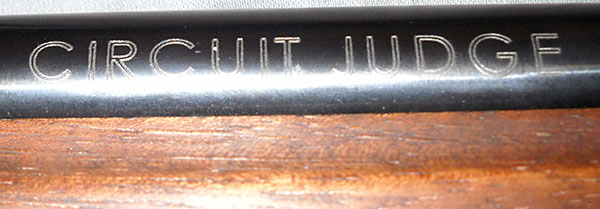
It's just what it says on the tin: a Taurus The Judge action, built into a handy little carbine by another Brazilian gun manufacturer, Amadeo Rossi. (I'm not 100% sure of the relationship between Rossi and Taurus; the latter bought the former's handgun operations a few years ago, and they obviously partnered on the Circuit Judge, but I don't think they have common ownership. It seems more like a variation on the old Winchester/Colt "look, we'll stay out of handguns if you stay out of long arms" arrangement.)
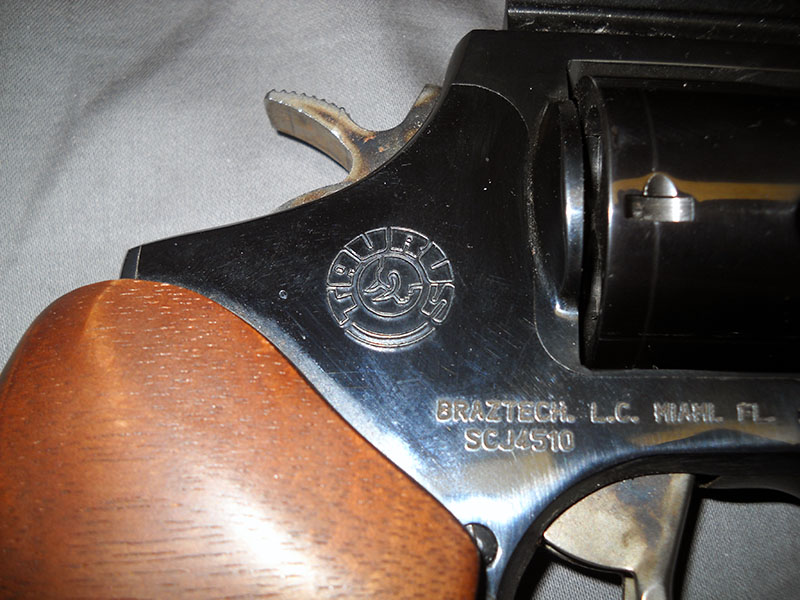
The frame has the standard Taurus markings, plus the imprint of Rossi's US importer. Meanwhile, Rossi's own logo appears in two more discreet places: the little rubber cap on the bottom of the semi-pistol-grip part of the stock, and the (oddly luxurious for a .410 shotgun) buttpad.
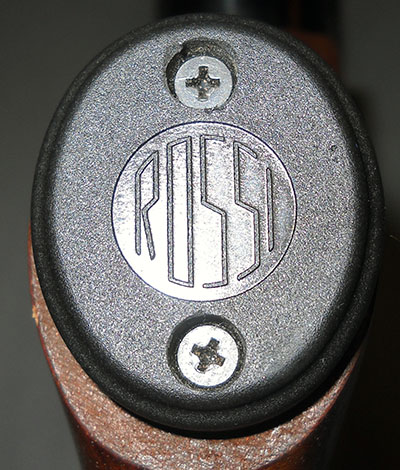
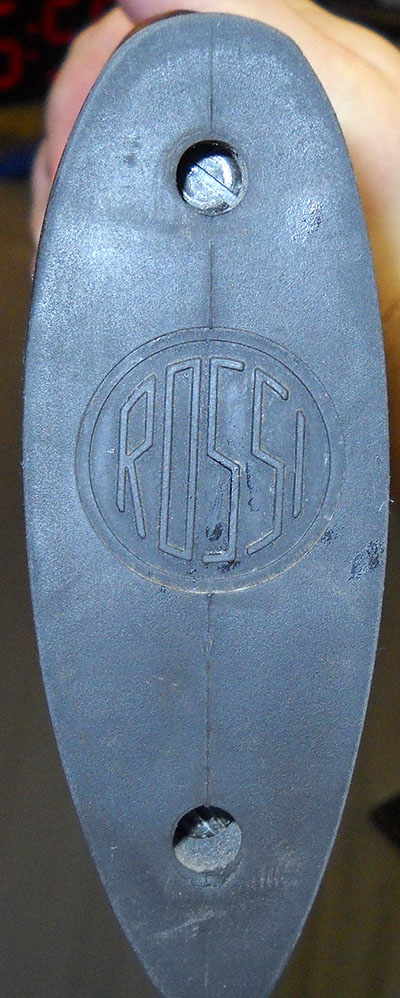
I'm not going to take the grip cap off, because those are probably wood screws and they don't really like being put in and taken out over and over again, but my guess is that it's hiding the bolt that holds the stock onto what would otherwise be the Judge's grip frame.
Note in the pic of the Taurus markings that the model number is (apart from the letters) the same as the pistol's, 4510—the Circuit Judge is literally a regular Judge handgun with a barrel long enough to meet NFA regs, a front handguard, and a shoulder stock instead of a grip.
Well, almost. It also has one nice little feature that addresses the major drawback all revolver carbines have had since Time Immemorial—namely, the problem of the cylinder gap. Long-time Gun of the Week readers may recall that this is a notorious danger zone in revolving firearms, which is not that much of a problem in a handgun if you hold it right; but in a carbine it's a significant hazard to the shooter's support arm. In the old days of blackpowder revolver carbines, the usual fix was to hold it right up close to the trigger guard, under the frame, which was awkward as hell and kind of obviated the advantage of making it a carbine in the first place.
Someone at either Taurus or Rossi (I'm guessing the latter, since they seem to have been responsible for all the other aspects of converting the Judge into a longarm) tackled the problem by adding little blast shields to the front.
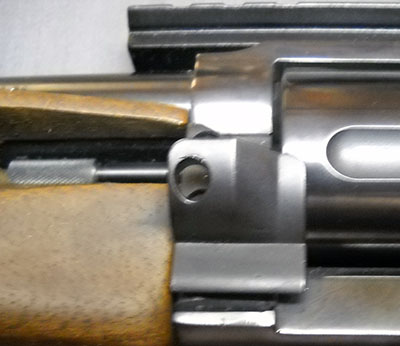
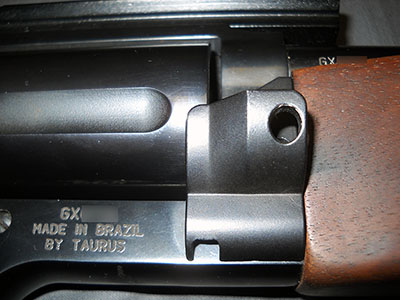
(Sorry for the odd color and slight blur in the lefthand pic; the flash didn't go for some reason. I decided to leave it in order to show how they had to cut back the handguard on that side for the ejector rod.)
The shield on the right side is fixed; the one on the left swings out with the cylinder. They obviously don't protect anything that's right next to the upper part of the cylinder, by the forcing cone, but if you've got anything up there you're Doing It Wrong anyway.
Most of the markings are on the right side; the only one on the left is the caliber marking, up on the base of the barrel.
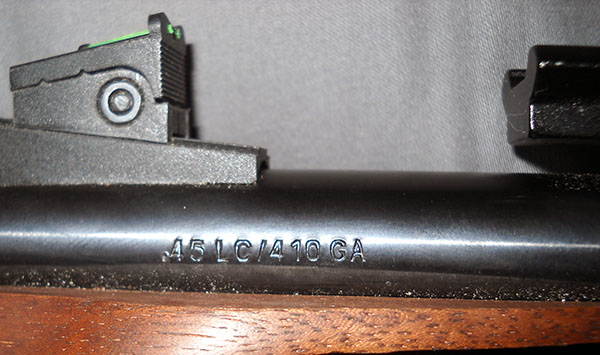
In that shot, you can also see the rear sight and the front of the built-in optic rail on the top of the frame. Leaving room for that rail makes the sight radius kind of short, since the rear iron sight is way out in front of everything on the barrel, but the sights themselves are quite nice. They've got little fiber-optic tubes in them, which, when viewed from the usual sighting position, make the dots show up brightly in normal light conditions—kind of a cool idea.
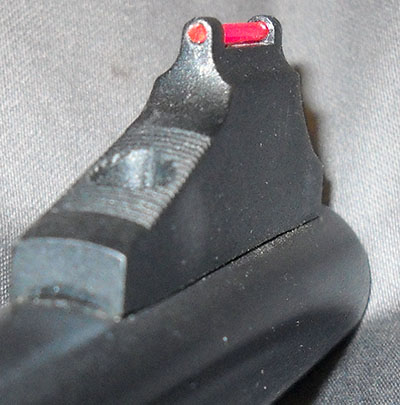
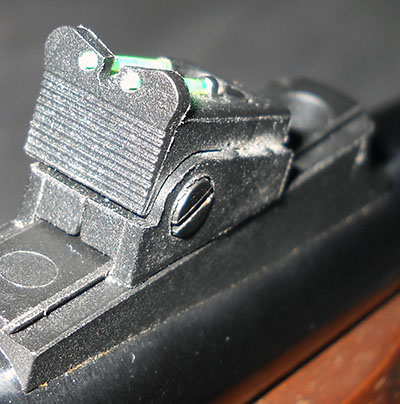
They're also in contrasting colors, which is nice; you can instantly tell if you've got them lined up in the wrong order. That sounds like a weird mistake to make, but if you're shooting in some haste (for instance, hunting birds), it could happen.
Unlike the handgun version, the carbine actually comes with a choice of choke (a screwed-in device out at the muzzle end of a shotgun that shapes the pattern of shot). You've got one exclusively for use with .410 shot, which makes a pattern the manual describes as suitable for turkey hunting, and another that protects the threads when you're shooting .45 LC. Mine came with the turkey choke installed, but I don't plan on doing much turkey hunting, so I'll probably swap it for the thread protector.
A little surprisingly for a used gun (people do seem to manage to lose this stuff with annoying regularity), it came with all the little fiddly bits—the second choke, the little spanner for swapping them out, a bore cleaner, even a little widget I eventually realized was a hammer extension.
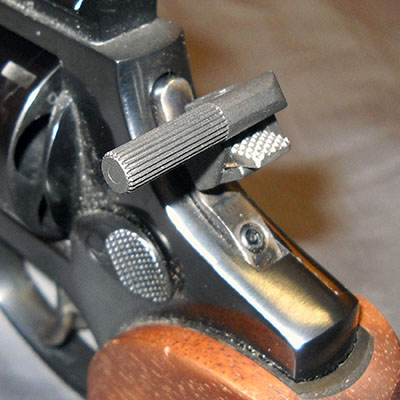
When I was a kid, my grandfather had one of those on an Ithaca Model 72 Saddlegun he had. The Saddlegun was a Winchester 1894 clone in .22 Rimfire Magnum, made for Ithaca by ERMA-Werke in (West) Germany in the '70s, and Gramp had put a scope on it. When you put a scope on a hammer-fired gun like a '94, the back of the scope overhangs the hammer and makes it inaccessible to the thumb, so you need to add a little sideways attachment to the hammer to make it get-attable again. I'm really surprised that my secondhand CJ's was still with it, that's the kind of thing that virtually always gets lost somewhere along the way.
So, the Circuit Judge. I sniffed around briefly for one of these after hearing that they existed, found that they were out of production, and more or less gave up, figuring that they'd be rare enough I would be unlikely to run across one used in any of the local gun shops... and then, randomly, ran across one in the shop nearest my house.² And the best part is, it basically didn't cost me anything!
Well, OK, I traded the Um, What The for it, but let's face it, I got most of my personal value from that just talking about the shock of seeing what it was after I ordered it. I'm likely to have a much better actual ownership experience with the CJ. Anyway, I think I actually got more in trade for it than I originally paid for it, which may be the only time I have ever made a (theoretical) profit on a gun deal.
--G.
¹ Not what it's actually called.
² Not counting the hardware store downtown, which only stocks a couple of shotguns and .22 rifles and doesn't deal in used stuff at all.